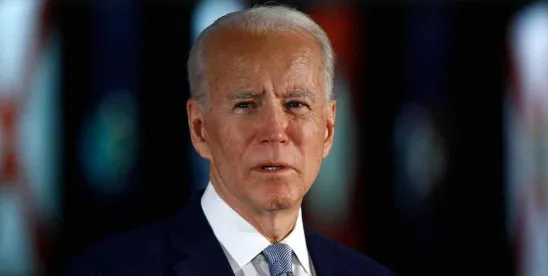Last night, President Joe Biden stood before a joint session of the 118th Congress to fulfill his constitutional duty: a president “shall from time to time give to the Congress Information of the State of the Union, and recommend to their Consideration such Measures as he shall judge necessary and expedient” (Article II, Section 3, Clause 1).
The President is halfway through his term, with high expectations that he will announce his reelection campaign shortly. Last Friday, the Bureau of Labor Statistics reported surprisingly good news for an administration beset by storm clouds of recession and inflation: the US economy added 517,000 jobs in January, with unemployment at 3.4% – a level not seen since 1969. President Biden celebrated the news as a testament that “the Biden economic plan is working.”
Three days later, a Washington Post-ABC News poll found 62% of Americans believe President Biden has accomplished “not very much” or “little or nothing” during his first two years in office.
President Biden used the televised address to press against the seemingly contradictory headlines and make the case for his policy positions. He reminded Americans of several legislative accomplishments during his term: the Infrastructure Investment and Jobs Act, the law investing in core infrastructure priorities; the CHIPS and Science Act, the law boosting American research and semiconductor manufacturing; and the Inflation Reduction Act, the Democratic budget reconciliation package that cut prescription drug and health costs, targeted investments in clean energy and sought to reduce the deficit. He also touted several bipartisan endeavors that resulted in codifying marriage equality, bolstering gun safety, reforming the Electoral Count Act, reauthorizing the Violence Against Women Act and supporting veterans who were exposed to toxic substances during their service.
The President set forth his vision for the coming two years, which he referenced as “restor[ing] the soul of the nation” and “rebuild[ing] the backbone of America.” He cited many policies of great interest to the Democratic Party’s base: reforming policing, enabling workers to join unions, banning assault weapons, supporting women’s reproductive health, ensuring voting rights and creating pathways to citizenship for Dreamers, those on temporary status, farm workers and essential workers. He called for cheaper insulin, paid medical leave, affordable childcare, consumer protections and investments in education. For deficit reduction, he championed policies that would require wealthy individuals and big corporations “to pay their fair share,” such as by implementing a minimum tax for billionaires and quadrupling the tax on corporate stock buybacks.
But a president does not win an additional four years in the White House simply by pleasing his party’s base. Last night, President Biden tried again to appeal to those who disagree with his policies or are otherwise unhappy with the direction of the country
Despite some vocal pushback from the Republican side of the aisle during his address, President Biden attempted to convey himself as a reasonable, bipartisan individual who can bring divided lawmakers together to address the needs of the nation. He discussed the increase in manufacturing jobs since he took office and his commitment to using American products for federal construction projects. He also spoke of his dedication to fighting fraud, supporting the country’s veterans, beating the opioid crisis and making great strides against cancer and other health conditions. He received applause throughout the chamber when he vowed to protect Americans’ privacy and go after Big Tech. He also referenced the Russia/Ukraine conflict, noting America “stood against Putin’s aggression” and “with the Ukrainian people.”
Governor Sarah Huckabee Sanders (R-AR), the youngest governor in the country, gave the Republican response to the State of the Union. Introducing herself as a mother, she said the Biden administration is failing the American people on inflation, crime, foreign policy and homeland security. She described the current White House as being financially irresponsible, and she called the Administration out of touch, “more interested in woke fantasies than the hard reality Americans face every day.” With a patriotic tone, she painted a picture of positive change from a new generation of leadership. She drew stark contrasts between herself and President Biden, from age, to gender, to political philosophies: “I’m for freedom, and he’s for government control.” She also previewed her education reform plan, which she said will empower parents, improve literacy and career readiness, and increase starting salaries for teachers. Finally, she chronicled her experience of traveling to Iraq as the White House press secretary, detailing the support the troops showed then-President Donald Trump and the support he provided them in return.
What to Expect From Capitol Hill
This was President Biden’s first State of the Union address with Speaker Kevin McCarthy (R-CA) on the dais, and divided government makes for a tough legislative environment on Capitol Hill. Republicans now hold a narrow, 10-seat majority in the House of Representatives1 , and Democrats hold the slimmest of majorities in the Senate. Beyond the numbers, each party holds diverse views, and it takes only a few lawmakers to hold up policymaking in each chamber.
President Biden and congressional lawmakers will have a difficult time threading the needle for successful legislative action this year.
Time will be an enemy.
The congressional calendar is limited, providing only so many days for committee and floor action. At the beginning of the year, the House Republican majority passed a new rules package, which prescribes the operating procedures for the House of Representatives. The package, which Speaker McCarthy negotiated as part of his run for leadership, is designed to empower more individual lawmakers – but it almost assuredly will continue to slow the legislative process.
Putting additional pressure on Speaker McCarthy to find consensus within his conference, a single lawmaker may now call for a vote to “vacate the chair” (remove the speaker). Lawmakers must be given 72 hours to review legislation, although the House majority has already ignored the rule, proving it is malleable in application. Members have vowed to bring up each of the 12 appropriations bills individually for votes, a practice that fell by the wayside in recent years due to time constraints; if appropriations are not passed at the end of the fiscal year or a continuing resolution is not enacted to allow an extension of the previous fiscal year’s funding levels on a temporary basis, the government may shut down. Additionally, Speaker McCarthy placed several firebrand conservative lawmakers on the Committee on Rules; these lawmakers could join with Democrats to block legislation from reaching the House floor if it is not to their liking.
The House and Senate will also spend time on separate endeavors that do not overlap. House Republicans are eager to enact their “Commitment to America” agenda, much of which will not find agreement with the Senate Democratic majority. Separately, the Senate has the sole power to consider and confirm the principal officers of the United States, almost all of the highest-level political appointments in the federal government..
Lawmakers are not just focused on legislation. Congress has the authority to conduct oversight and investigations, derived from the Constitution and several Supreme Court decisions. House Republicans may issue subpoenas in an effort to compel participation in depositions, and President Biden, his family and the administration are all in their sights. They are also inclined to go after “woke” corporations and business executives. On the Senate side of the Capitol, Democrats have broken free from the 50-50 partisan split of the last two years, and can now issue subpoenas unilaterally. They may go after the individuals and groups supporting the House Republicans in their investigations.
Success will come from bipartisanship.
As we stated in our 2022 mid-term election analysis, compromise will be necessary to overcome legislative gridlock. There are several items on the congressional agenda that are ripe for bipartisan action.
-
Farm Bill. The “farm bill” is a legislative package, developed about every five years, that governs a variety of agricultural and food programs. The most recent farm bill, the Agriculture Improvement Act of 2018, generally expires on September 30. Because of the all-encompassing nature of the bill – it includes titles on government nutrition programs, commodities, crop insurance and conservation, to name a few – both Democrats and Republicans are interested and motivated to work on the legislation. Additionally, Senate Committee on Agriculture Chair Debbie Stabenow (D-MI) has recently announced she will not run for reelection, and we anticipate she will want to make her mark on the last farm bill under her tenure.
-
Fiscal Year 2024 National Defense Authorization Act. The annual defense authorization, while not a “must-pass” bill, has been enacted reliably for the past 62 years. The bill does not provide budget authority, but it establishes policy and authorizes appropriations for the Department of Defense and defense-related activities across the federal government. Republicans have expressed a desire to cap discretionary spending, but House Committee on Armed Services Chair Mike Rogers (R-AL) has said the NDAA’s topline will be “as big as it needs to be” to ensure national security.
-
Federal Aviation Administration Reauthorization. The current FAA authorization is set to end on September 30, and the reauthorization will set years-long aviation policies and reforms in a time when various consumer issues and the Notice to Air Missions (NOTAM) system outage have been in the headlines. The last reauthorization, enacted in 2018 after multiple short-term extensions, authorized US$96.7 billion in spending over five years.
-
Fiscal Year 2024 Appropriations. President Biden is expected to submit his budget to Congress on March 9, and he called on Republicans to put forward their proposed spending plan on that day, as well. Congress must then pass appropriations bills to fund government programs for the next fiscal year, which begins October 1. Most current appropriations can be extended through short- or long-term continuing resolutions, but Republicans will be loath to extend funding levels determined under the last congress’s Democratic control to the upcoming year. House Republicans have pledged to cut discretionary spending to Fiscal Year 2022 levels, but this will take negotiation. A lapse in funding would result in a government shutdown – and no smart politician on either side of the aisle wants the blame for that scenario.
-
Data Privacy Legislation. Last year, a bipartisan group of three prominent lawmakers in the House and Senate released the American Data Privacy and Protection Act, a comprehensive national data privacy and data security framework. The bill, which gained momentum more than any other privacy bill in recent years, never made it to the House floor – in part due to the opposition of then-Speaker of the House Nancy Pelosi and several other lawmakers from California, a state that wants to preserve its own data privacy legislation. President Biden is interested in taking on Big Tech regulation and privacy issues and Speaker McCarthy, who is from California but does not carry the same allegiances to Silicon Valley as his predecessor, has previously expressed interest in privacy legislation.
Two issues mentioned by President Biden will take precedence in headlines in the coming months: the debt ceiling and China.
Debt Ceiling
“Let us commit here tonight that the full faith and credit of the United States of America will never, ever be questioned. Some of my Republican friends want to take the economy hostage unless I agree to their economic plans. All of you at home should know what their plans are.”
The debt limit (or debt ceiling) is the total amount of outstanding debt that the US Department of the Treasury can incur. Last night, President Biden called on Congress to take action to protect the full faith and credit of the United States by raising the debt ceiling.
When the President met with Speaker McCarthy last week, the White House said the debt limit increase “is not negotiable or conditional,” but that President Biden “welcomes a separate discussion with congressional leaders about how to reduce the deficit and control the national debt while continuing to grow the economy.” Last night, the President reiterated that he will not agree to cut entitlements or reduce discretionary spending as a condition of Congress fulfilling its obligation to raise the debt ceiling, but he remains open to a separate discussion about ways to reduce the deficit while continuing to grow the economy. (In a livelier scene of the night, Republicans vocally rebuked the President’s claims that some individuals in their party want to sunset Social Security and Medicare. The President then responded to the lawmakers: “So folks, as we all apparently agree, Social Security and Medicare are off the books now.”)
Some historical context is necessary to understand how and why we are facing this pressing, timely issue.
In order to help finance US involvement in World War I, Congress created the debt ceiling in 1917 as part of a bill that authorized the Treasury Department to issue bonds and take on other debt without specific congressional approval, as long as the total debt fell under the statutory debt ceiling. Through the Second Liberty Bond Act, Congress set the debt ceiling at US$15 billion.
As expressed in absolute dollars, the national debt has increased under every president since Herbert Hoover. On the eve of World War II, the national debt had reached US$49 billion, as in 49 with a “B.” In 2021, Congress approved a joint resolution setting the statutory debt limit at US$31.381 trillion, as in 31.4 with a “T.”
On January 19, Treasury Secretary Janet Yellen notified Congress that the federal government’s outstanding debt was projected to have reached the statutory limit. She therefore indicated that the Treasury Department had commenced using “extraordinary measures” to avoid breaching the debt ceiling. In fact, the Treasury Department came within US$25 million of breaching the ceiling.
What are “extraordinary measures” and how long can she use them?In essence, extraordinary measures are actions undertaken to reduce what counts against the debt limit, such as suspending certain types of investments in savings and health plans for government workers. The Treasury Department also can temporarily move money between government agencies and departments to make payments as they come due. And it can suspend the daily reinvestment of securities held by the Treasury’s Exchange Stabilization Fund, a bucket of money for buying and selling currencies and providing financing to foreign governments.
In this instance, Secretary Yellen said she would redeem existing investments and suspend new investments in the Civil Service Retirement and Disability Fund and the Postal Service Retiree Health Benefits Fund. Further, she suspended reinvestment of the Government Securities Investment Fund of the Federal Employees Retirement System Thrift Savings Plan. These measures will be in place through June 3. A few days later, she announced some additional extraordinary measures to buy more time.
So, is June 3 the “X-Date,” the date by which Congress must act? Probably not, because the Secretary has other extraordinary measures that she could deploy. But there are limits to her authority and time is not on her side.
What options does Congress have available?
-
Congress could pass legislation simply “suspending” the debt ceiling for some period of time. That is probably the easiest route. For example, House Republicans could vote to suspend the ceiling until September 30 to tie a further debt ceiling vote to Fiscal Year 2024 spending with the hope that the White House and Senate will go along.
-
Congress could pass legislation raising the debt ceiling to some higher amount, which many House Republicans are loath to do without getting a commitment from the White House to substantially cut spending. No doubt reflecting his experience as Vice President in 2011, President Biden has been adamant that he will not do so. Setting a red line, he has repeatedly said he will not even discuss that option – and doubled down on his position last night.
-
Congress could pass a bill prioritizing the payment of obligations coming due, such as paying off bonds as they mature, continuing to fund Social Security and Medicare and funding the military. Consider the implications: Chinese bondholders would be paid before farmers would receive loans, students would not get Pell Grants and many children would be denied school lunches. If House Republicans were to pursue this approach, you can be pretty sure the President will be channeling Clint Eastwood in the film Sudden Impact: “Go ahead, make my day.”
-
• Congress could set the debt limit as a percentage of Gross National Product (GNP) or simply repeal it altogether, but that is not likely, either.
-
Had House Republicans not eliminated the “Gephardt rule” (named for a former Democratic leader) as part of the changes to the Rules of the House that now govern the 118th Congress, they could have suspended the debt ceiling by approving a budget resolution. In its prior form, House Rule XXVIII provided that, following adoption of a concurrent resolution on the budget, the Clerk of the House was directed to engross a joint resolution suspending the debt limit for that fiscal year. If the Senate approved the joint resolution in that form, it would go to the President for his signature. But with the Gephardt rule eliminated (as it was in the 112th Congress before being resurrected), this option is no longer available.
-
And before this debate plays out, there will be more breathless speculation about the notion of the Bureau of the Mint producing a trillion-dollar coin to be “deposited” in the Treasury’s account at the Federal Reserve. Secretary Yellen already has dismissed this gimmick. In any event, the teller window does not appear to be open. Federal Reserve Chair Jerome Powell recently threw cold water on the idea, saying: “There’s only one way forward here, and that is for Congress to raise the debt ceiling so that the United States government can pay all of its obligations when due.”
-
The Administration also could go into court, seeking a declaratory judgment that the law is unconstitutional. It would have some very good arguments to make but going to court and getting a declaratory judgment seem unlikely.
That puts the ball back on Capitol Hill, where it has been since 1917.
China
“I am committed to work with China where it can advance American interests and benefit the world. But make no mistake: as we made clear last week, if China threatens our sovereignty, we will act to protect our country. And we did.”
During his speech, President Biden vowed to protect the United States from threats posed by China, just days after he ordered a Chinese surveillance balloon shot down (though he made only oblique reference to that incident). Committing to keeping the nation safe, and precipitated by concern about how he handled the incident, President Biden simply said, “Make no mistake about it: as we made clear last week, if China threatens our sovereignty, we will act to protect our country. And we did.”
Otherwise, President Biden’s speech focused generally on the US posture and policy to China, asserting that his administration has put the United States in “the strongest position in decades to compete” with Beijing after a period during which the “People’s Republic of China was increasing its power and America was falling in the world.” President Biden made clear that the United States would cooperate with China where possible, but he made “no apologies [to China] that [the United States is] investing to make America strong ... [i]nvesting in American innovation, in industries that will define the future, and that China’s government is intent on dominating.” He touted his efforts to modernize the military “to safeguard stability and deter aggression.”
On technology, President Biden said, “I’ve made clear with President Xi that we seek competition, not conflict. Investing in our alliances and working with our allies to protect our advanced technologies so they’re not used against us.”
Finally, inviting bipartisan cooperation to help maintain global competitiveness of US businesses, President Biden concluded, “And let’s be clear: winning the competition with China should unite all of us.”
Quite clearly, the White House declined the invitation from pundits to elaborate on the President’s handling of the balloon incident and, rather, reserved a fulsome defense of the administration’s aggressive and, in some cases, unprecedented moves on China – which include efforts to build Indo-Pacific cooperation that balances China’s power in the region, reinforce US support for Taiwan, establish a new industrial policy and export controls on high-end semiconductors, and enhance security cooperation with the Republic of Korea and Japan – for another time.







 />i
/>i

